Deposition velocities of some natural radionuclides from the atmosphere at Ninh Thuan and Dong Nai of Vietnam
The deposition velocities of Be-7, K-40, Th-232, U-238 and Pb-210 radionuclides from the
atmosphere at Ninh Thuan and Dong Nai monitoring stations of Vietnam were investigated. The
deposition velocity was calculated based on it’s specific radioactivity in aerosols and deposition
density in fallout samples. The data of the deposition velocities of radionuclides from the atmosphere
are needed as input data for the models to simulate atmospheric radioactive dispersion and assess the
public dose around nuclear facilities. The radioactivity of Be-7, K-40, Th-232, U-238 and Pb-210
nuclides in aerosols and fallout samples were analyzed by using a low level background gamma
spectrometer equipped with HPGe detector of high resolution. The results show that the deposition
velocities of Be-7, K-40, Th-232, U-238 and Pb-210 nuclides from the air are in ranges of 0.04÷1.71;
1.84÷27.46; 1.46÷23.63; 0.80÷26.13 and 0.06÷1.53 (cm/s), with average values of 0.55; 13.81; 8.22;
8.12 and 0.58 (cm/s), respectively. The deposition velocities of the radionuclides in the survey areas
are comparable with those found in tropical and subtropical regions and these results could be served
as the database of the World radioactive transport parameters
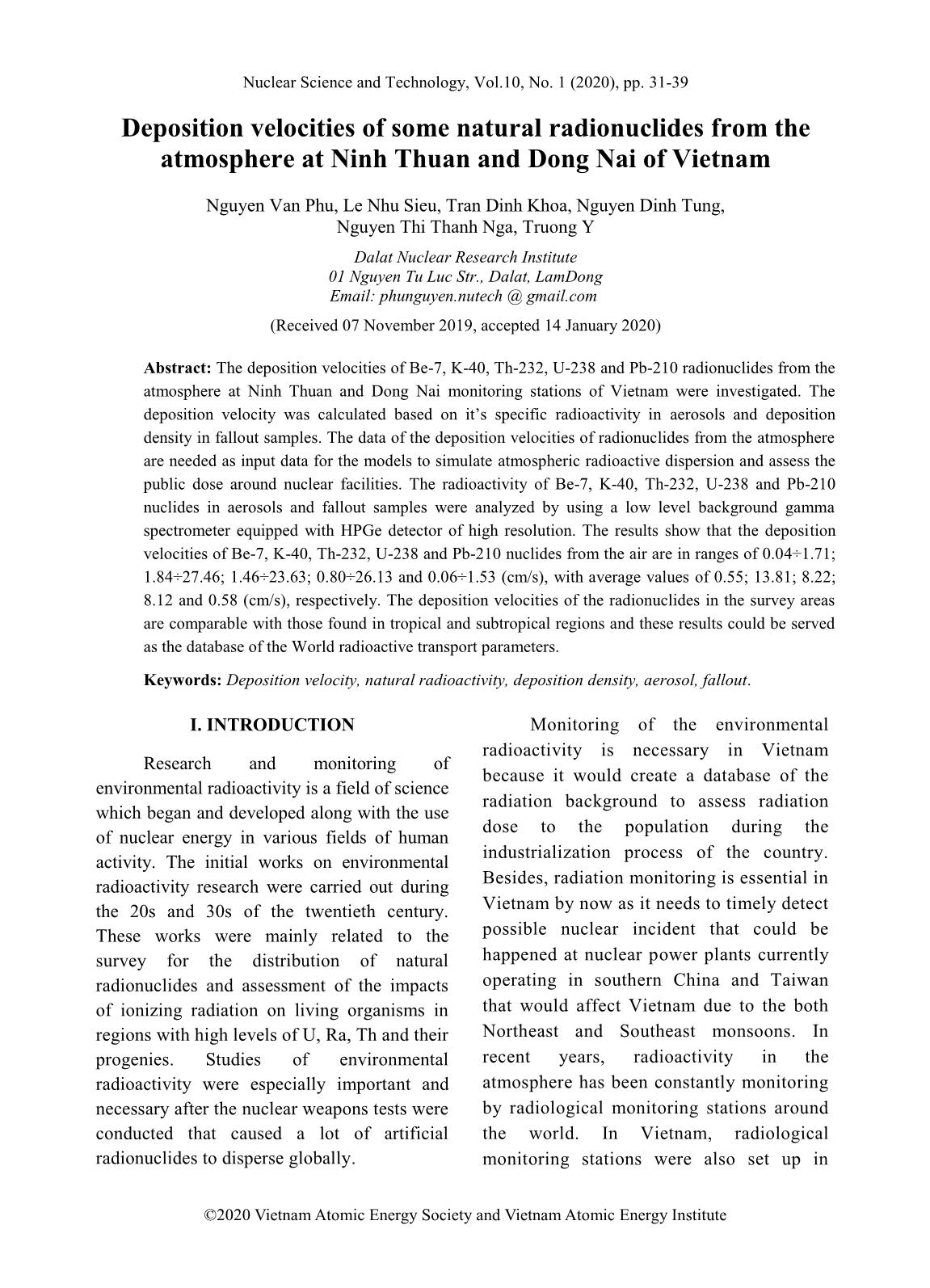
Trang 1
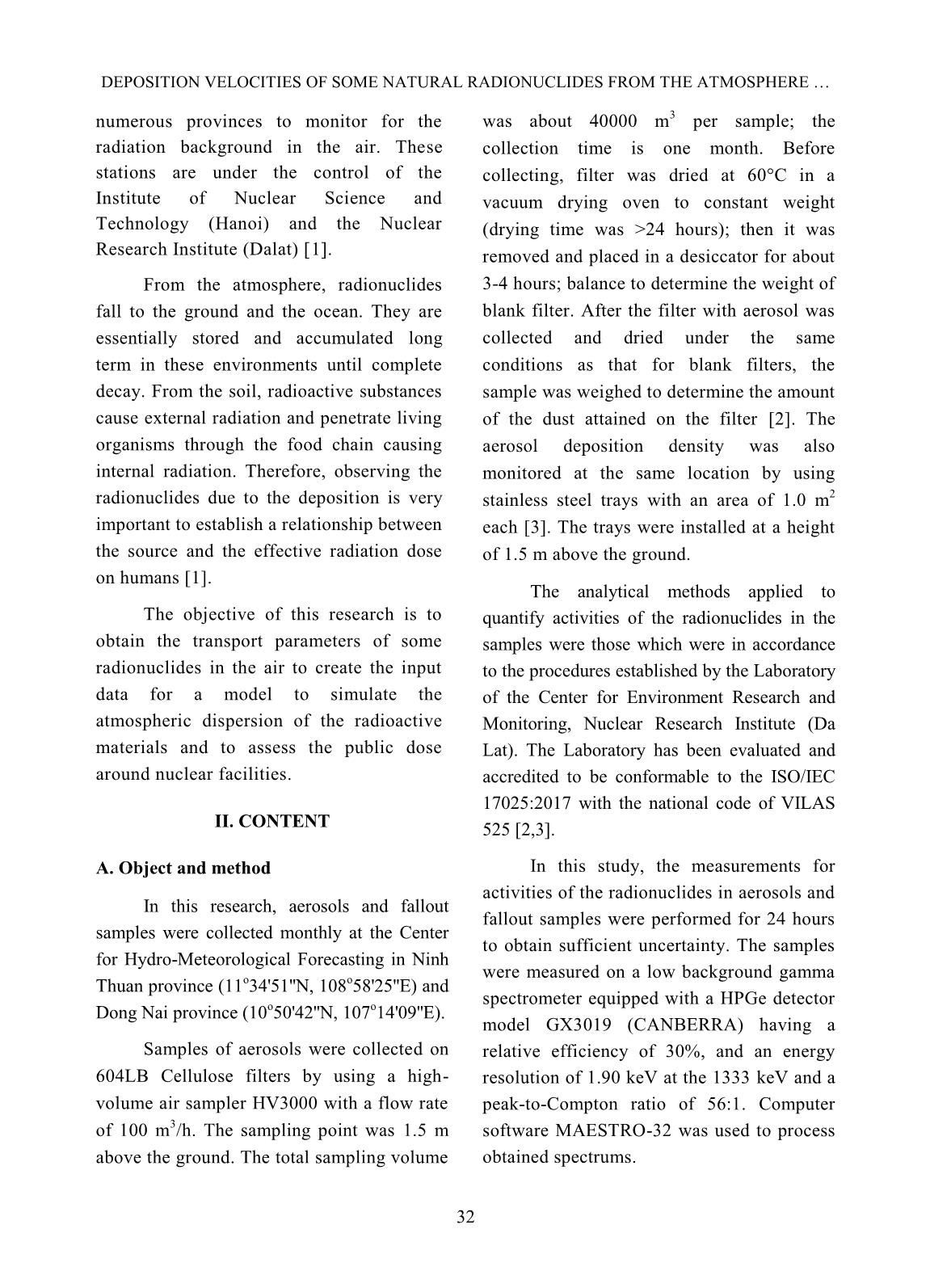
Trang 2
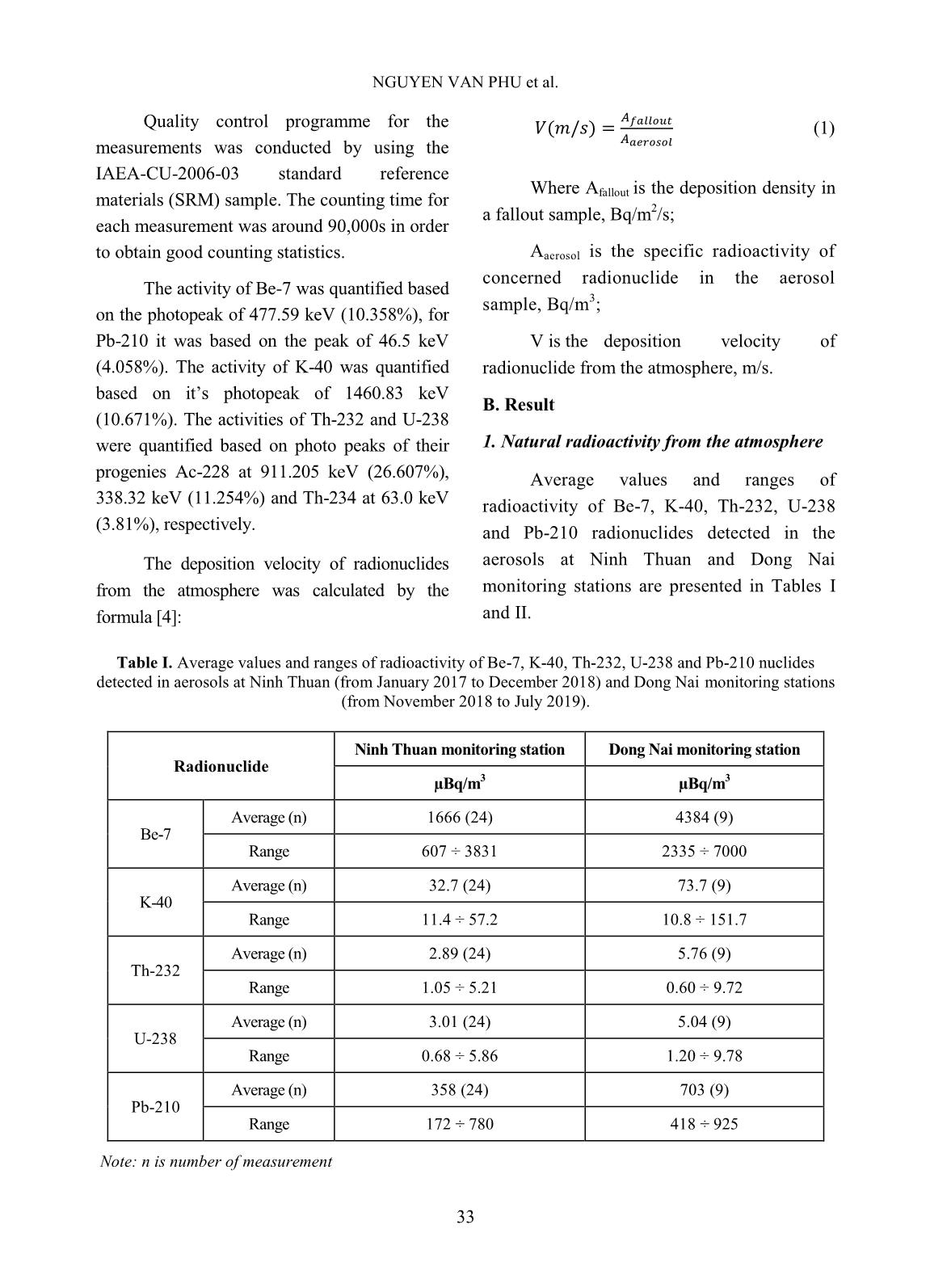
Trang 3
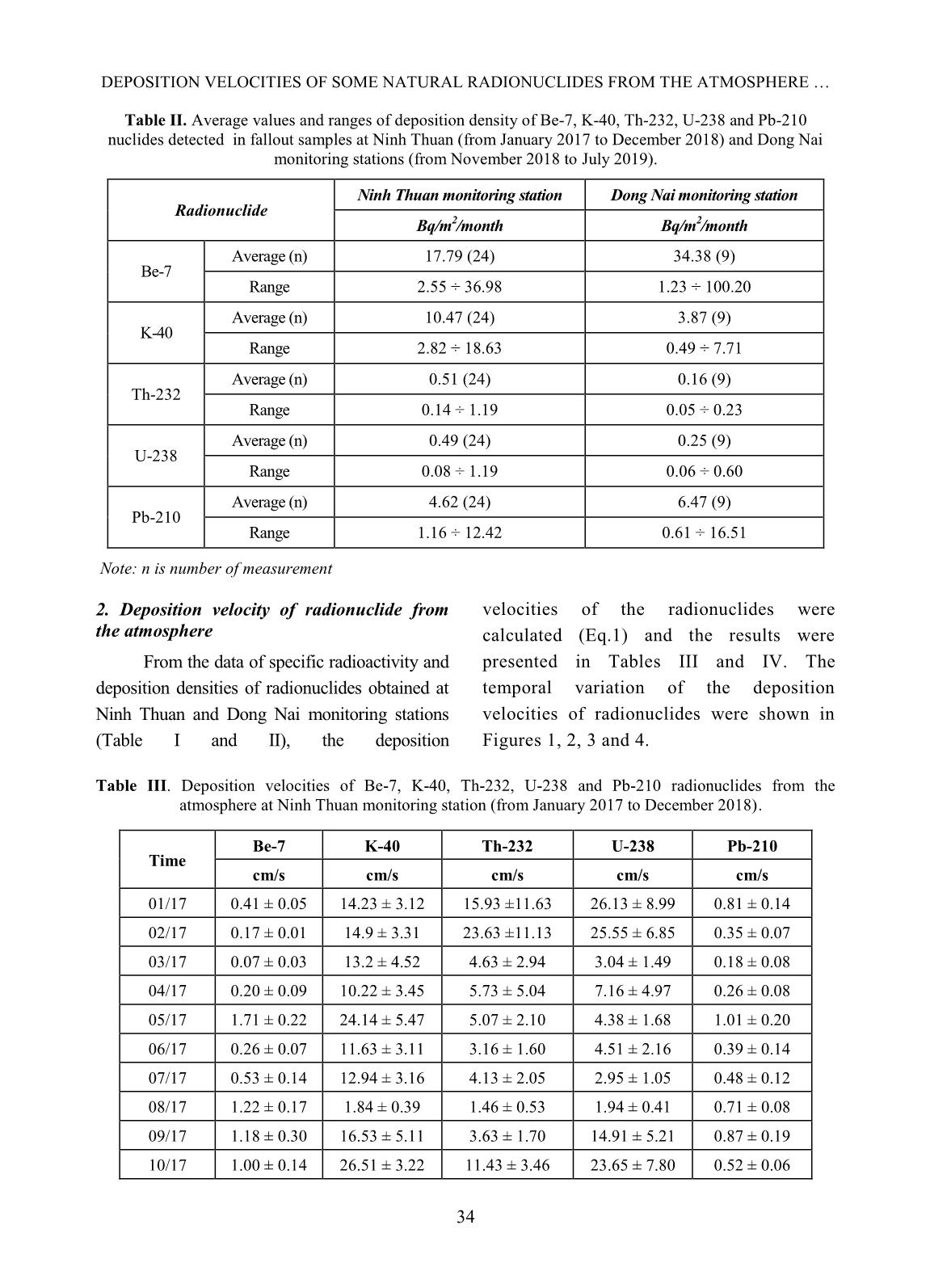
Trang 4
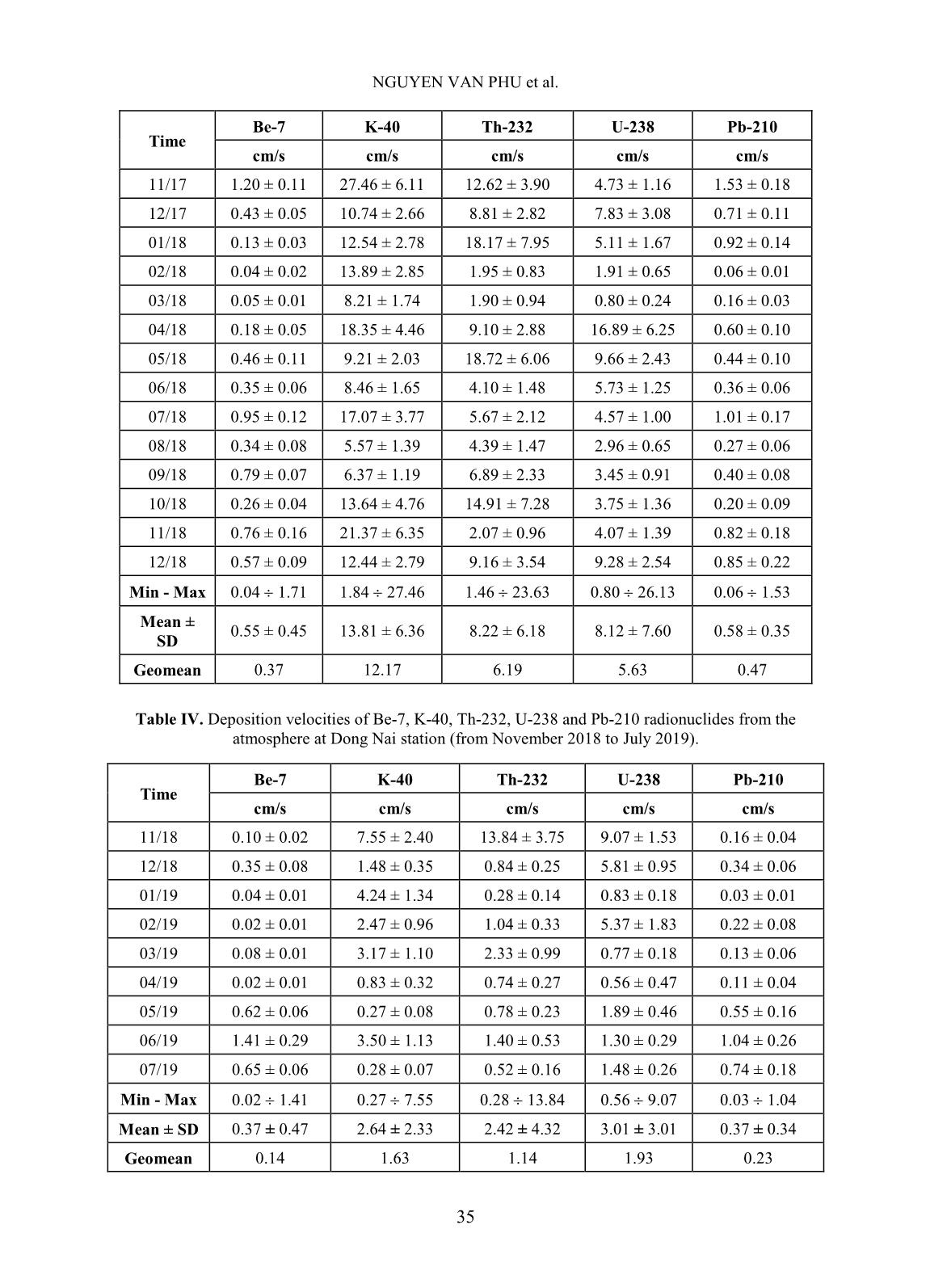
Trang 5
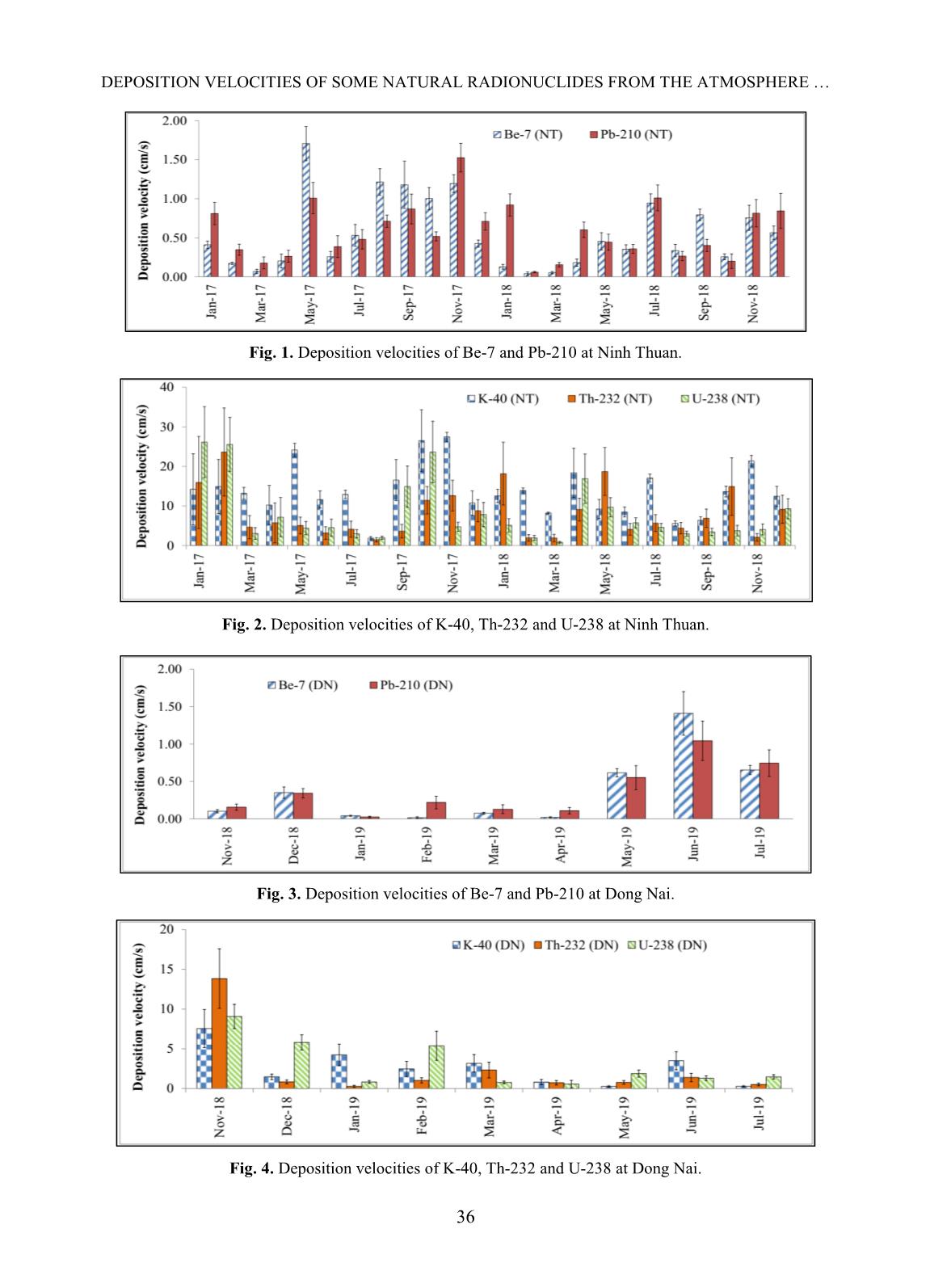
Trang 6
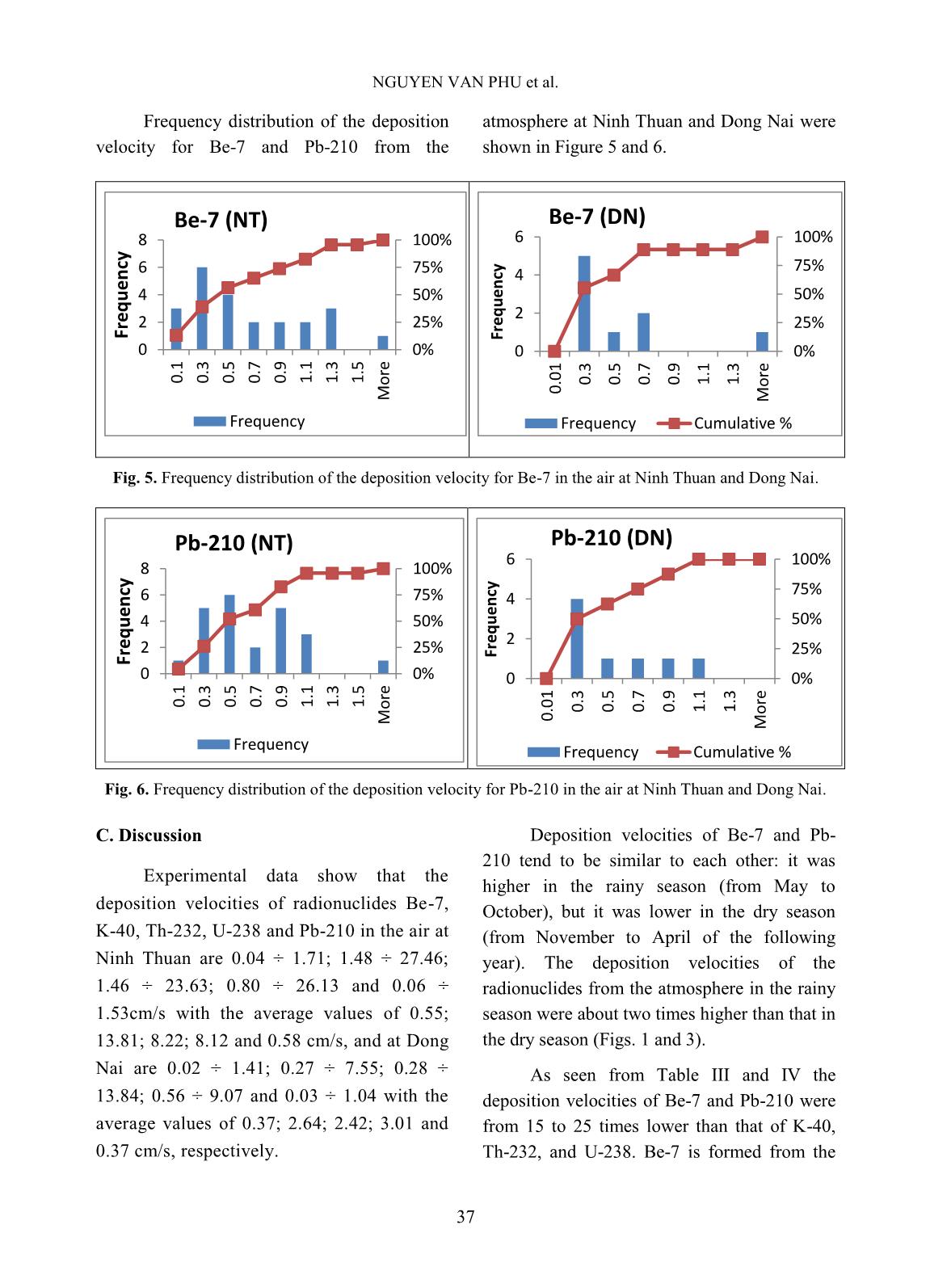
Trang 7
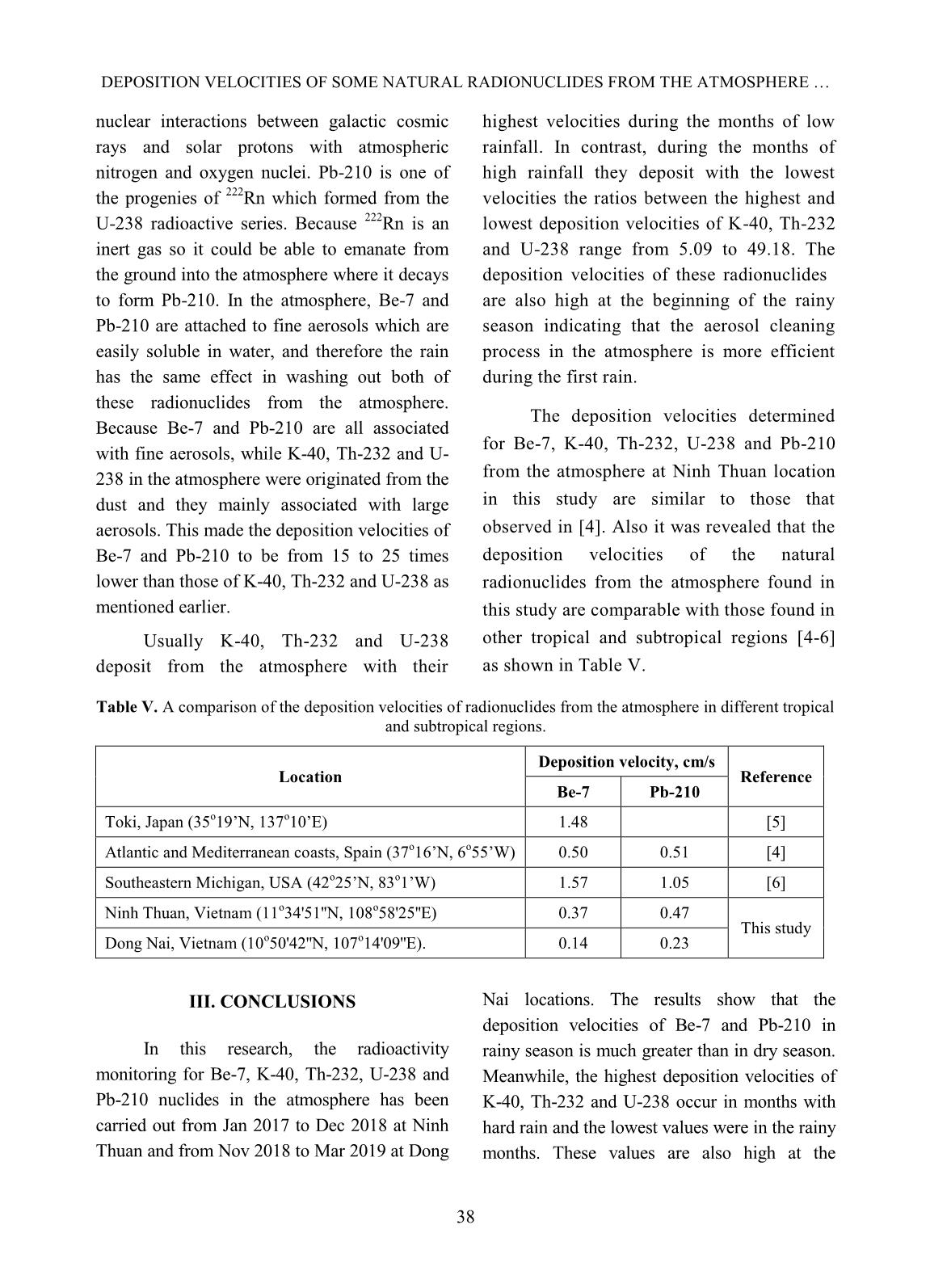
Trang 8
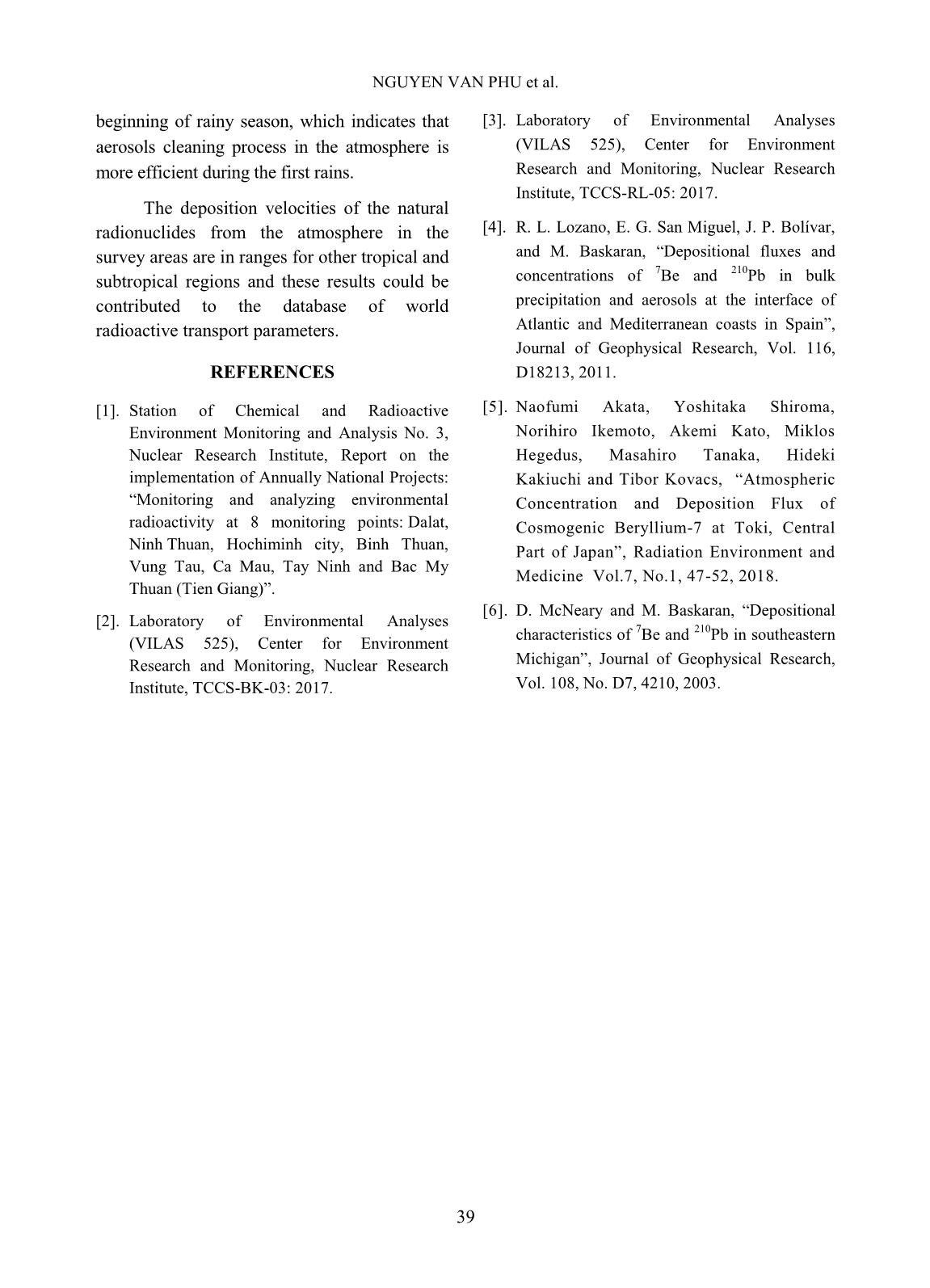
Trang 9
Tóm tắt nội dung tài liệu: Deposition velocities of some natural radionuclides from the atmosphere at Ninh Thuan and Dong Nai of Vietnam
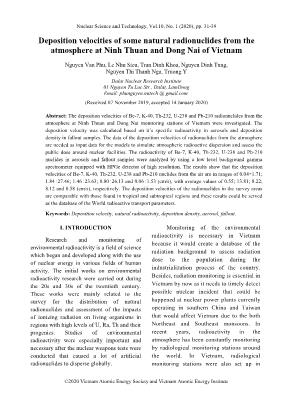
tical methods applied to quantify activities of the radionuclides in the samples were those which were in accordance to the procedures established by the Laboratory of the Center for Environment Research and Monitoring, Nuclear Research Institute (Da Lat). The Laboratory has been evaluated and accredited to be conformable to the ISO/IEC 17025:2017 with the national code of VILAS 525 [2,3]. In this study, the measurements for activities of the radionuclides in aerosols and fallout samples were performed for 24 hours to obtain sufficient uncertainty. The samples were measured on a low background gamma spectrometer equipped with a HPGe detector model GX3019 (CANBERRA) having a relative efficiency of 30%, and an energy resolution of 1.90 keV at the 1333 keV and a peak-to-Compton ratio of 56:1. Computer software MAESTRO-32 was used to process obtained spectrums. NGUYEN VAN PHU et al. 33 Quality control programme for the measurements was conducted by using the IAEA-CU-2006-03 standard reference materials (SRM) sample. The counting time for each measurement was around 90,000s in order to obtain good counting statistics. The activity of Be-7 was quantified based on the photopeak of 477.59 keV (10.358%), for Pb-210 it was based on the peak of 46.5 keV (4.058%). The activity of K-40 was quantified based on it’s photopeak of 1460.83 keV (10.671%). The activities of Th-232 and U-238 were quantified based on photo peaks of their progenies Ac-228 at 911.205 keV (26.607%), 338.32 keV (11.254%) and Th-234 at 63.0 keV (3.81%), respectively. The deposition velocity of radionuclides from the atmosphere was calculated by the formula [4]: (1) Where Afallout is the deposition density in a fallout sample, Bq/m 2 /s; Aaerosol is the specific radioactivity of concerned radionuclide in the aerosol sample, Bq/m 3 ; V is the deposition velocity of radionuclide from the atmosphere, m/s. B. Result 1. Natural radioactivity from the atmosphere Average values and ranges of radioactivity of Be-7, K-40, Th-232, U-238 and Pb-210 radionuclides detected in the aerosols at Ninh Thuan and Dong Nai monitoring stations are presented in Tables I and II. Table I. Average values and ranges of radioactivity of Be-7, K-40, Th-232, U-238 and Pb-210 nuclides detected in aerosols at Ninh Thuan (from January 2017 to December 2018) and Dong Nai monitoring stations (from November 2018 to July 2019). Radionuclide Ninh Thuan monitoring station Dong Nai monitoring station µBq/m 3 µBq/m 3 Be-7 Average (n) 1666 (24) 4384 (9) Range 607 ÷ 3831 2335 ÷ 7000 K-40 Average (n) 32.7 (24) 73.7 (9) Range 11.4 ÷ 57.2 10.8 ÷ 151.7 Th-232 Average (n) 2.89 (24) 5.76 (9) Range 1.05 ÷ 5.21 0.60 ÷ 9.72 U-238 Average (n) 3.01 (24) 5.04 (9) Range 0.68 ÷ 5.86 1.20 ÷ 9.78 Pb-210 Average (n) 358 (24) 703 (9) Range 172 ÷ 780 418 ÷ 925 Note: n is number of measurement DEPOSITION VELOCITIES OF SOME NATURAL RADIONUCLIDES FROM THE ATMOSPHERE 34 Table II. Average values and ranges of deposition density of Be-7, K-40, Th-232, U-238 and Pb-210 nuclides detected in fallout samples at Ninh Thuan (from January 2017 to December 2018) and Dong Nai monitoring stations (from November 2018 to July 2019). Radionuclide Ninh Thuan monitoring station Dong Nai monitoring station Bq/m 2 /month Bq/m 2 /month Be-7 Average (n) 17.79 (24) 34.38 (9) Range 2.55 ÷ 36.98 1.23 ÷ 100.20 K-40 Average (n) 10.47 (24) 3.87 (9) Range 2.82 ÷ 18.63 0.49 ÷ 7.71 Th-232 Average (n) 0.51 (24) 0.16 (9) Range 0.14 ÷ 1.19 0.05 ÷ 0.23 U-238 Average (n) 0.49 (24) 0.25 (9) Range 0.08 ÷ 1.19 0.06 ÷ 0.60 Pb-210 Average (n) 4.62 (24) 6.47 (9) Range 1.16 ÷ 12.42 0.61 ÷ 16.51 Note: n is number of measurement 2. Deposition velocity of radionuclide from the atmosphere From the data of specific radioactivity and deposition densities of radionuclides obtained at Ninh Thuan and Dong Nai monitoring stations (Table I and II), the deposition velocities of the radionuclides were calculated (Eq.1) and the results were presented in Tables III and IV. The temporal variation of the deposition velocities of radionuclides were shown in Figures 1, 2, 3 and 4. Table III. Deposition velocities of Be-7, K-40, Th-232, U-238 and Pb-210 radionuclides from the atmosphere at Ninh Thuan monitoring station (from January 2017 to December 2018). Time Be-7 K-40 Th-232 U-238 Pb-210 cm/s cm/s cm/s cm/s cm/s 01/17 0.41 ± 0.05 14.23 ± 3.12 15.93 ±11.63 26.13 ± 8.99 0.81 ± 0.14 02/17 0.17 ± 0.01 14.9 ± 3.31 23.63 ±11.13 25.55 ± 6.85 0.35 ± 0.07 03/17 0.07 ± 0.03 13.2 ± 4.52 4.63 ± 2.94 3.04 ± 1.49 0.18 ± 0.08 04/17 0.20 ± 0.09 10.22 ± 3.45 5.73 ± 5.04 7.16 ± 4.97 0.26 ± 0.08 05/17 1.71 ± 0.22 24.14 ± 5.47 5.07 ± 2.10 4.38 ± 1.68 1.01 ± 0.20 06/17 0.26 ± 0.07 11.63 ± 3.11 3.16 ± 1.60 4.51 ± 2.16 0.39 ± 0.14 07/17 0.53 ± 0.14 12.94 ± 3.16 4.13 ± 2.05 2.95 ± 1.05 0.48 ± 0.12 08/17 1.22 ± 0.17 1.84 ± 0.39 1.46 ± 0.53 1.94 ± 0.41 0.71 ± 0.08 09/17 1.18 ± 0.30 16.53 ± 5.11 3.63 ± 1.70 14.91 ± 5.21 0.87 ± 0.19 10/17 1.00 ± 0.14 26.51 ± 3.22 11.43 ± 3.46 23.65 ± 7.80 0.52 ± 0.06 NGUYEN VAN PHU et al. 35 Time Be-7 K-40 Th-232 U-238 Pb-210 cm/s cm/s cm/s cm/s cm/s 11/17 1.20 ± 0.11 27.46 ± 6.11 12.62 ± 3.90 4.73 ± 1.16 1.53 ± 0.18 12/17 0.43 ± 0.05 10.74 ± 2.66 8.81 ± 2.82 7.83 ± 3.08 0.71 ± 0.11 01/18 0.13 ± 0.03 12.54 ± 2.78 18.17 ± 7.95 5.11 ± 1.67 0.92 ± 0.14 02/18 0.04 ± 0.02 13.89 ± 2.85 1.95 ± 0.83 1.91 ± 0.65 0.06 ± 0.01 03/18 0.05 ± 0.01 8.21 ± 1.74 1.90 ± 0.94 0.80 ± 0.24 0.16 ± 0.03 04/18 0.18 ± 0.05 18.35 ± 4.46 9.10 ± 2.88 16.89 ± 6.25 0.60 ± 0.10 05/18 0.46 ± 0.11 9.21 ± 2.03 18.72 ± 6.06 9.66 ± 2.43 0.44 ± 0.10 06/18 0.35 ± 0.06 8.46 ± 1.65 4.10 ± 1.48 5.73 ± 1.25 0.36 ± 0.06 07/18 0.95 ± 0.12 17.07 ± 3.77 5.67 ± 2.12 4.57 ± 1.00 1.01 ± 0.17 08/18 0.34 ± 0.08 5.57 ± 1.39 4.39 ± 1.47 2.96 ± 0.65 0.27 ± 0.06 09/18 0.79 ± 0.07 6.37 ± 1.19 6.89 ± 2.33 3.45 ± 0.91 0.40 ± 0.08 10/18 0.26 ± 0.04 13.64 ± 4.76 14.91 ± 7.28 3.75 ± 1.36 0.20 ± 0.09 11/18 0.76 ± 0.16 21.37 ± 6.35 2.07 ± 0.96 4.07 ± 1.39 0.82 ± 0.18 12/18 0.57 ± 0.09 12.44 ± 2.79 9.16 ± 3.54 9.28 ± 2.54 0.85 ± 0.22 Min - Max 0.04 1.71 1.84 27.46 1.46 23.63 0.80 26.13 0.06 1.53 Mean ± SD 0.55 ± 0.45 13.81 ± 6.36 8.22 ± 6.18 8.12 ± 7.60 0.58 ± 0.35 Geomean 0.37 12.17 6.19 5.63 0.47 Table IV. Deposition velocities of Be-7, K-40, Th-232, U-238 and Pb-210 radionuclides from the atmosphere at Dong Nai station (from November 2018 to July 2019). Time Be-7 K-40 Th-232 U-238 Pb-210 cm/s cm/s cm/s cm/s cm/s 11/18 0.10 ± 0.02 7.55 ± 2.40 13.84 ± 3.75 9.07 ± 1.53 0.16 ± 0.04 12/18 0.35 ± 0.08 1.48 ± 0.35 0.84 ± 0.25 5.81 ± 0.95 0.34 ± 0.06 01/19 0.04 ± 0.01 4.24 ± 1.34 0.28 ± 0.14 0.83 ± 0.18 0.03 ± 0.01 02/19 0.02 ± 0.01 2.47 ± 0.96 1.04 ± 0.33 5.37 ± 1.83 0.22 ± 0.08 03/19 0.08 ± 0.01 3.17 ± 1.10 2.33 ± 0.99 0.77 ± 0.18 0.13 ± 0.06 04/19 0.02 ± 0.01 0.83 ± 0.32 0.74 ± 0.27 0.56 ± 0.47 0.11 ± 0.04 05/19 0.62 ± 0.06 0.27 ± 0.08 0.78 ± 0.23 1.89 ± 0.46 0.55 ± 0.16 06/19 1.41 ± 0.29 3.50 ± 1.13 1.40 ± 0.53 1.30 ± 0.29 1.04 ± 0.26 07/19 0.65 ± 0.06 0.28 ± 0.07 0.52 ± 0.16 1.48 ± 0.26 0.74 ± 0.18 Min - Max 0.02 1.41 0.27 7.55 0.28 13.84 0.56 9.07 0.03 1.04 Mean ± SD 0.37 ± 0.47 2.64 ± 2.33 2.42 ± 4.32 3.01 ± 3.01 0.37 ± 0.34 Geomean 0.14 1.63 1.14 1.93 0.23 DEPOSITION VELOCITIES OF SOME NATURAL RADIONUCLIDES FROM THE ATMOSPHERE 36 Fig. 1. Deposition velocities of Be-7 and Pb-210 at Ninh Thuan. Fig. 2. Deposition velocities of K-40, Th-232 and U-238 at Ninh Thuan. Fig. 3. Deposition velocities of Be-7 and Pb-210 at Dong Nai. Fig. 4. Deposition velocities of K-40, Th-232 and U-238 at Dong Nai. NGUYEN VAN PHU et al. 37 Frequency distribution of the deposition velocity for Be-7 and Pb-210 from the atmosphere at Ninh Thuan and Dong Nai were shown in Figure 5 and 6. Fig. 5. Frequency distribution of the deposition velocity for Be-7 in the air at Ninh Thuan and Dong Nai. Fig. 6. Frequency distribution of the deposition velocity for Pb-210 in the air at Ninh Thuan and Dong Nai. C. Discussion Experimental data show that the deposition velocities of radionuclides Be-7, K-40, Th-232, U-238 and Pb-210 in the air at Ninh Thuan are 0.04 ÷ 1.71; 1.48 ÷ 27.46; 1.46 ÷ 23.63; 0.80 ÷ 26.13 and 0.06 ÷ 1.53cm/s with the average values of 0.55; 13.81; 8.22; 8.12 and 0.58 cm/s, and at Dong Nai are 0.02 ÷ 1.41; 0.27 ÷ 7.55; 0.28 ÷ 13.84; 0.56 ÷ 9.07 and 0.03 ÷ 1.04 with the average values of 0.37; 2.64; 2.42; 3.01 and 0.37 cm/s, respectively. Deposition velocities of Be-7 and Pb- 210 tend to be similar to each other: it was higher in the rainy season (from May to October), but it was lower in the dry season (from November to April of the following year). The deposition velocities of the radionuclides from the atmosphere in the rainy season were about two times higher than that in the dry season (Figs. 1 and 3). As seen from Table III and IV the deposition velocities of Be-7 and Pb-210 were from 15 to 25 times lower than that of K-40, Th-232, and U-238. Be-7 is formed from the 0% 25% 50% 75% 100% 0 2 4 6 8 0 .1 0. 3 0 .5 0 .7 0 .9 1 .1 1 .3 1 .5 M o re Fr eq u e n cy Be-7 (NT) Frequency 0% 25% 50% 75% 100% 0 2 4 6 0. 0 1 0 .3 0 .5 0 .7 0 .9 1 .1 1 .3 M o re Fr eq u e n cy Be-7 (DN) Frequency Cumulative % 0% 25% 50% 75% 100% 0 2 4 6 8 0. 1 0. 3 0. 5 0. 7 0. 9 1. 1 1. 3 1. 5 M o re Fr eq u en cy Pb-210 (NT) Frequency 0% 25% 50% 75% 100% 0 2 4 6 0. 0 1 0. 3 0. 5 0. 7 0. 9 1. 1 1. 3 M o re Fr eq u en cy Pb-210 (DN) Frequency Cumulative % DEPOSITION VELOCITIES OF SOME NATURAL RADIONUCLIDES FROM THE ATMOSPHERE 38 nuclear interactions between galactic cosmic rays and solar protons with atmospheric nitrogen and oxygen nuclei. Pb-210 is one of the progenies of 222 Rn which formed from the U-238 radioactive series. Because 222 Rn is an inert gas so it could be able to emanate from the ground into the atmosphere where it decays to form Pb-210. In the atmosphere, Be-7 and Pb-210 are attached to fine aerosols which are easily soluble in water, and therefore the rain has the same effect in washing out both of these radionuclides from the atmosphere. Because Be-7 and Pb-210 are all associated with fine aerosols, while K-40, Th-232 and U- 238 in the atmosphere were originated from the dust and they mainly associated with large aerosols. This made the deposition velocities of Be-7 and Pb-210 to be from 15 to 25 times lower than those of K-40, Th-232 and U-238 as mentioned earlier. Usually K-40, Th-232 and U-238 deposit from the atmosphere with their highest velocities during the months of low rainfall. In contrast, during the months of high rainfall they deposit with the lowest velocities the ratios between the highest and lowest deposition velocities of K-40, Th-232 and U-238 range from 5.09 to 49.18. The deposition velocities of these radionuclides are also high at the beginning of the rainy season indicating that the aerosol cleaning process in the atmosphere is more efficient during the first rain. The deposition velocities determined for Be-7, K-40, Th-232, U-238 and Pb-210 from the atmosphere at Ninh Thuan location in this study are similar to those that observed in [4]. Also it was revealed that the deposition velocities of the natural radionuclides from the atmosphere found in this study are comparable with those found in other tropical and subtropical regions [4-6] as shown in Table V. Table V. A comparison of the deposition velocities of radionuclides from the atmosphere in different tropical and subtropical regions. Location Deposition velocity, cm/s Reference Be-7 Pb-210 Toki, Japan (35 o19’N, 137o10’E) 1.48 [5] Atlantic and Mediterranean coasts, Spain (37 o16’N, 6o55’W) 0.50 0.51 [4] Southeastern Michigan, USA (42 o25’N, 83o1’W) 1.57 1.05 [6] Ninh Thuan, Vietnam (11 o 34'51''N, 108 o 58'25''E) 0.37 0.47 This study Dong Nai, Vietnam (10 o 50'42''N, 107 o 14'09''E). 0.14 0.23 III. CONCLUSIONS In this research, the radioactivity monitoring for Be-7, K-40, Th-232, U-238 and Pb-210 nuclides in the atmosphere has been carried out from Jan 2017 to Dec 2018 at Ninh Thuan and from Nov 2018 to Mar 2019 at Dong Nai locations. The results show that the deposition velocities of Be-7 and Pb-210 in rainy season is much greater than in dry season. Meanwhile, the highest deposition velocities of K-40, Th-232 and U-238 occur in months with hard rain and the lowest values were in the rainy months. These values are also high at the NGUYEN VAN PHU et al. 39 beginning of rainy season, which indicates that aerosols cleaning process in the atmosphere is more efficient during the first rains. The deposition velocities of the natural radionuclides from the atmosphere in the survey areas are in ranges for other tropical and subtropical regions and these results could be contributed to the database of world radioactive transport parameters. REFERENCES [1]. Station of Chemical and Radioactive Environment Monitoring and Analysis No. 3, Nuclear Research Institute, Report on the implementation of Annually National Projects: “Monitoring and analyzing environmental radioactivity at 8 monitoring points: Dalat, Ninh Thuan, Hochiminh city, Binh Thuan, Vung Tau, Ca Mau, Tay Ninh and Bac My Thuan (Tien Giang)”. [2]. Laboratory of Environmental Analyses (VILAS 525), Center for Environment Research and Monitoring, Nuclear Research Institute, TCCS-BK-03: 2017. [3]. Laboratory of Environmental Analyses (VILAS 525), Center for Environment Research and Monitoring, Nuclear Research Institute, TCCS-RL-05: 2017. [4]. R. L. Lozano, E. G. San Miguel, J. P. Bolívar, and M. Baskaran, “Depositional fluxes and concentrations of 7 Be and 210 Pb in bulk precipitation and aerosols at the interface of Atlantic and Mediterranean coasts in Spain”, Journal of Geophysical Research, Vol. 116, D18213, 2011. [5]. Naofumi Akata, Yoshitaka Shiroma, Norihiro Ikemoto, Akemi Kato, Miklos Hegedus, Masahiro Tanaka, Hideki Kakiuchi and Tibor Kovacs, “Atmospheric Concentration and Deposition Flux of Cosmogenic Beryllium-7 at Toki, Central Part of Japan”, Radiation Environment and Medicine Vol.7, No.1, 47-52, 2018. [6]. D. McNeary and M. Baskaran, “Depositional characteristics of 7 Be and 210 Pb in southeastern Michigan”, Journal of Geophysical Research, Vol. 108, No. D7, 4210, 2003.
File đính kèm:
 deposition_velocities_of_some_natural_radionuclides_from_the.pdf
deposition_velocities_of_some_natural_radionuclides_from_the.pdf

